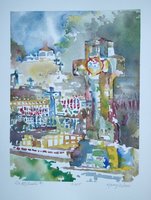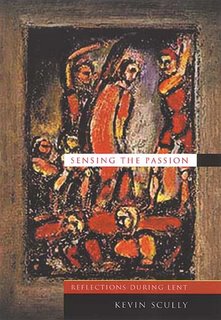This exhibit was on display from March 4, 2006 - May 14, 2006 at the Sackler Gallery in Washington D.C. Many of the paintings, prints and other works are from the collection of Charles Lang Freer. Freer was the founder of the Freer Gallery of Art which connects to the Sackler Gallery through an underground passage.
From the time I started seeing the advertising for this exhibit in local publications and on the metro, I knew I had to go see it. I had no idea what an interesting character Hokusai was!
Hokusai (pronounced hoe·koo·sigh) began his artistic career as a woodcut engraver when he was but a teenager. He next learned to paint kabuki actors from a master, Katsukawa Shunsho . The exhibit had quite a large collection of these prints which were extremely popular in their day.

I found the majority of these works skilled, but they elicited very little emotion from me. The exception to this statement would be two pieces at the end of that section. (They may or may not be part of the kabuki work, but were in the same time period.) One work depicted teenage girls applying makeup.
The composition has a very modern and western flair and was quite appealing. Another had a young boy with a hairbrush. Both seemed somehow out of place for the 1800's; I can see how he could have greatly influenced Western artists.

Hokusai is probably best known for a painting nicknamed "The Great Wave." This was the work used to advertise the show here in DC. I must admit that the forms and colors were terrific, but I had never noticed the small people huddled in the boat until I visited the show. The print was much smaller than I had anticipated. (Perhaps because many of the publicity posters were five feet tall?)It was part of a series 36 Views of Mt. Fuji. (Later he did ten additional views.)

He did other series as well. From the One Thousand Pictures of the Ocean series, my favorite work was "Whaling Off the Goto Islands." (shown at right)

My favorite item in the whole show was a book of Single Brushstroke Drawings dated 1832 and owned by the British Museum. All the items, people and animals depicted were fresh and caught the essence of the form in one stroke. Amazing. The closest image I could find is this one. It is not "one stroke" but the same essence I saw in those.

Other images I loved were Ducks in Flowing Water and a turtle one whose title I did not record. In Ducks... you could see the duck above water and the feet below. Hokusai had even blurred some forms to give the optical effect of the water's movement.
In general, I did not love the paintings in the downstairs exhibit. I liked the geese in the Months of the Year screen series, and I liked the Egret's feet, "Cock and Hen," and the opossums.
The sheer volume of work that "The Old Man Mad About Painting" produced induced awe. Each time he changed his style or tried to escape commissions he changed his name. Each of his names used would have been respectable career on its own, but together they are a marvel.





















